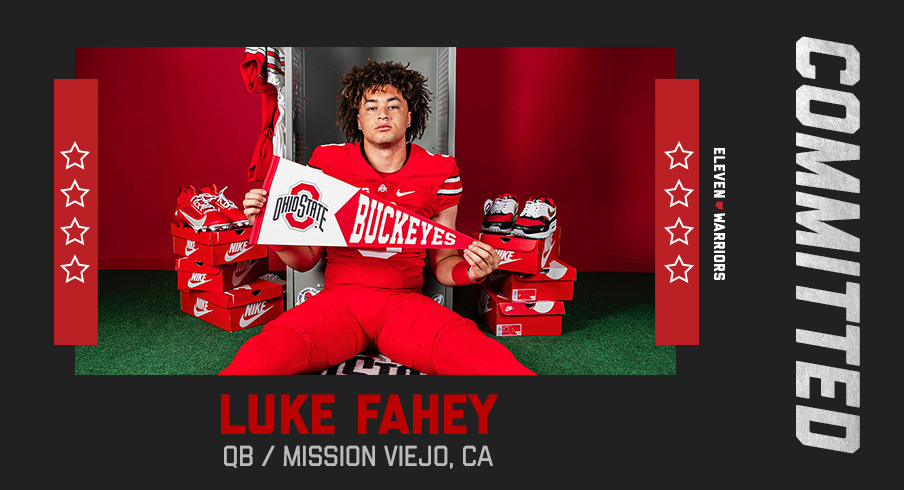Ohio State football has long been one of the sport’s most prominent pipelines for elite quarterbacks, and their recent success in recruiting signal-callers from California has only amplified their offensive firepower. With the commitment of Luke Fahey, a surgically precise passer out of the Golden State, the Buckeyes continue to solidify their West Coast-to-Columbus connection under head coach Ryan Day. Fahey, known for his laser accuracy, cool demeanor, and advanced football IQ, is not only a perfect fit for Ohio State’s quarterback-centric system—he also continues a trend that traces back to Heisman-caliber talent and NFL-ready development.
This article explores Fahey’s commitment, his background, why his skill set is ideal for the Buckeyes, and how he follows in the footsteps of California quarterbacks like C.J. Stroud. His arrival marks not just the acquisition of another top prospect—but a reaffirmation of Ohio State’s identity under Ryan Day: precision, poise, and production.
California to Columbus: A Proven QB Pipeline
The Buckeyes’ romance with California quarterbacks hit a high point when C.J. Stroud, a relatively under-recruited prospect from Rancho Cucamonga, burst onto the national scene. Under Day’s tutelage, Stroud became a two-time Heisman finalist and the No. 2 overall pick in the 2023 NFL Draft by the Houston Texans. His precision passing, sharp reads, and calm leadership style became the model for future quarterbacks in Day’s system.
Ohio State followed up with Julian Sayin, another Californian from Carlsbad, before he flipped to Alabama and later transferred to Ohio State. Sayin’s return to Columbus only further emphasized how much faith quarterbacks from California have in the Buckeyes’ development path. And now, Luke Fahey becomes the latest in this prestigious lineage.
A 6-foot-2, 195-pound standout from St. Bonaventure High School in Ventura, Fahey fits the mold of what Ohio State values in a quarterback: high football IQ, elite anticipation, clean mechanics, and a calm-under-pressure mentality. Ranked among the top quarterbacks in the 2026 class, Fahey is already drawing comparisons to Stroud because of his command of the pocket and pinpoint accuracy.
Who is Luke Fahey?
Luke Fahey’s name may still be emerging nationally, but in California football circles, he’s already a household name. A multi-year starter at St. Bonaventure, he quickly earned the respect of coaches, analysts, and rivals alike for his:
- Quick release and accuracy: Fahey thrives on rhythm throws and consistently delivers passes on time.
- Decision-making: His interception-to-touchdown ratio reflects his maturity and ability to read complex coverages.
- Leadership: Despite his youth, Fahey commands his huddle like a seasoned veteran.
- Poise: He doesn’t get rattled—something that became especially clear in comeback wins and high-pressure playoff games.
During his sophomore season, Fahey threw for over 3,000 yards with a 70% completion rate, tallying 32 touchdowns to just 3 interceptions. He’s proven equally effective under center and in shotgun, in play-action and spread looks—versatility that aligns with Day’s playbook.
“Ohio State develops quarterbacks like no other,” Fahey said during his commitment announcement. “It’s a school where precision matters, and that’s how I play. Coach Day’s offense is a dream fit.”
Ryan Day’s Quarterback Factory
One of the driving factors in Fahey’s decision to commit early is Ryan Day’s unparalleled reputation for grooming quarterbacks. Since taking the reins as head coach, Day has emphasized mechanics, timing, and mastery of the offensive playbook—all areas where Fahey already excels.
Day’s system prioritizes pre-snap recognition and post-snap decisiveness. It rewards quarterbacks who are not just physically talented, but mentally prepared—traits that Fahey exhibits in abundance. From Justin Fields to C.J. Stroud and now potentially Luke Fahey, Day’s vision remains clear: develop quarterbacks who can read the entire field and make defenses pay with surgical precision.
“Coach Day breaks the game down like a scientist,” Fahey said. “When I visited, we spent over an hour going through film. It wasn’t just recruiting—it was teaching. That’s when I knew it was home.”
Fit in the Buckeyes’ Offensive System
Ohio State’s offense has evolved to adapt to the strengths of its quarterbacks, and with Fahey in the pipeline, the program appears to be preparing for another era of surgical passing attacks. Where someone like Kyle McCord relied more on arm strength and Devin Brown on athleticism, Fahey brings a balance of accuracy and cerebral play that mirrors Stroud’s dominance.
In Fahey, Ohio State sees:
- A quick processor who can dissect defensive looks and audible with confidence.
- A timing-based thrower who hits routes at the top of breaks.
- A quarterback who can thrive in RPO (Run-Pass Option) scenarios and vertical shot plays alike.
- A young leader who doesn’t flinch in critical moments.
These traits not only align with Ohio State’s offensive identity but raise the ceiling on what the Buckeyes can be post-Sayin. Even if Fahey redshirts or sits for a year behind an upperclassman, his long-term upside could rival any recent Ohio State QB.
Building a California Legacy in Columbus
With Fahey’s commitment, Ohio State has now signed or landed commitments from three elite California quarterbacks in just a few years. That’s no coincidence. Under recruiting coordinator Mark Pantoni and quarterbacks coach Corey Dennis, the Buckeyes have built strong ties to California high school programs and private trainers—like quarterback guru Danny Hernandez, who helped develop Stroud and now works with Fahey.
“I’ve trained a lot of guys,” Hernandez said. “Luke’s accuracy and understanding of leverage—he’s ahead of where most are at this stage. He reminds me a lot of C.J. in how he sees the game.”
There’s a growing belief among California quarterbacks that if you want to be NFL-ready, you go to Columbus—not necessarily Los Angeles or Eugene. The Buckeyes’ history of producing top-tier QBs (Fields, Stroud, and possibly Sayin) gives them unmatched credibility in that regard.
What This Means for Ohio State’s Future
Landing Fahey sends several key messages:
- Ohio State remains an elite QB destination: Even amid fierce competition from SEC powerhouses and Big Ten rivals, Ohio State continues to secure high-level quarterbacks early in the cycle.
- Ryan Day’s recruiting strategy is working: Fahey’s early commitment builds momentum in the 2026 class and signals to receivers and offensive linemen that the Buckeyes’ future remains bright.
- Long-term development is prioritized: Ohio State doesn’t just recruit five-star tools—they invest in quarterbacks who understand the long game. With Fahey, the Buckeyes may be getting a long-term starter who could compete as early as 2027.
- West Coast dominance expands: The Buckeyes now routinely pull talent from California, not just at QB but across skill positions—a development that enhances their national recruiting footprint.
The Bigger Picture: NIL, Patience, and Development
In the modern era of college football, quarterback recruiting is a delicate balance between promise and patience. The transfer portal is always looming. NIL dollars add another layer of complexity. Fahey’s commitment, however, signals a throwback mentality. He’s less concerned with instant stardom and more focused on development and fit.
“Other schools talked about money,” Fahey admitted. “Ohio State talked about making me the best quarterback in the country. That’s the difference.”
That commitment to long-term development over short-term flash is what continues to separate Ohio State. Players like Fahey don’t just sign on for the jersey—they buy into the culture, the mentorship, and the vision.



